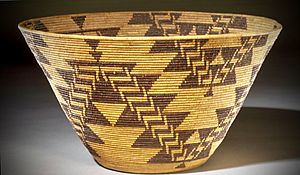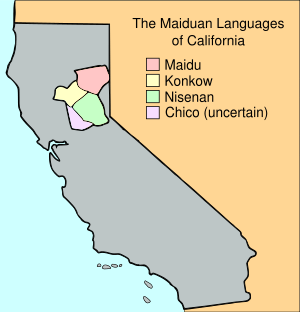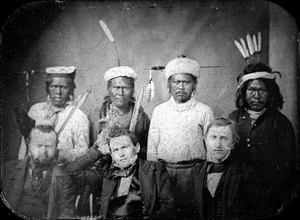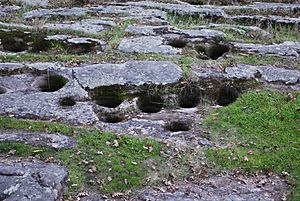Maidu facts for kids

Maidu coiled basket by Mary Kea'a'ala Azbill, circa 1900
|
|
| Total population | |
|---|---|
| 2,500 | |
| Regions with significant populations | |
| United States of America ( |
|
| Languages | |
| English, Maidu | |
| Religion | |
| Animistic (incl. syncretistic forms), other |
The Maidu are a group of Native American people. They live in northern California. Their homes are in the central Sierra Nevada mountains. This area includes the Feather and American Rivers. In their own language, maidu means "man".
Contents
Maidu Communities and Regions
The Maidu people live in different areas across northeastern Central California. They are divided into several groups or bands. Each group identifies with its own valleys, foothills, and mountains.
The three main Maidu groups are:
- The Nisenan or Southern Maidu. They lived along the American, Bear, and Yuba Rivers. Their lands were once home to the Martis.
- The Northeastern or Mountain Maidu. These are also known as Yamani Maidu. They lived on the upper parts of the Feather River.
- The Konkow (Koyom'kawi/Concow). They lived in a valley near present-day Cherokee and Pulga. This area is along the north fork of the Feather River. The Mechupda are a Konkow group living near Chico, California.
Maidu Population Over Time
Historians have estimated the number of Native Americans in California before Europeans arrived. For the Maidu, estimates for the year 1770 were around 9,000 to 9,500 people.
By 1910, the Maidu population had dropped to about 1,100. This decline was due to new diseases and changes to their way of life. In 1930, only 93 Maidu people were counted. However, the population has grown since then. By 1995, it had recovered to an estimated 3,500 people.
Maidu Culture and Traditions
Amazing Maidu Baskets
Maidu women were very skilled at weaving baskets. They made detailed and useful baskets of all sizes. Some were as small as thimbles, while others were huge. Some large baskets could be 10 feet or more across. The weaving was so fine that sometimes you needed a magnifying glass to see the threads.
They made many types of baskets. These included watertight baskets for cooking. They also made large storage baskets, bowls, trays, traps, cradles, hats, and tools for gathering seeds.
Maidu weavers used many different wild plants. These included fern roots, redbud bark, willow twigs, and sedge roots. By mixing these plants, they created beautiful geometric designs. These designs were in colors like red, black, white, brown, or tan.
Marie Potts, a Maidu elder, explained their weaving. She said they used both coiled and twining methods. Weavers often added decorations. These could be feathers, shells, quills, seeds, or beads. They used almost anything that could be attached.
How the Maidu Found Food
Like many other California tribes, the Maidu were hunters and gatherers. They did not farm. They managed their gathering areas carefully. They often used fire to help plants grow better.
Acorns were their most important food. They took great care of oak trees to get as many acorns as possible. Acorns were a main part of their dietary staple.
Preparing acorns was a long process, done by women and children. First, they shelled and cleaned the acorns. Then, they ground them into a meal. This was done by pounding them with a pestle on a hard stone. Acorns have a bitter substance called tannic acid. This had to be removed. They spread the acorn meal on pine needles over sand. Warm water was poured over it for several hours. This process removed the acid and flavored the meal.
The Maidu stored many acorns for winter. They built large storage structures above ground. These were called granaries.
Besides acorns, the Maidu ate other plants. They gathered edible roots and tubers. They also collected seeds from many flowering plants. Men hunted deer, elk, antelope, and smaller animals. They hunted with respect for the animals. Fish were also an important source of food. Men caught fish from streams and rivers. They caught salmon when they swam upstream to lay eggs.
Maidu Homes
In the hills and mountains, the Maidu built their homes partly underground. This helped protect them from the cold. These houses were large, round structures. They were 12 to 18 feet wide. The floors were dug up to 3 feet below ground.
After digging the floor, they built a frame with poles. They covered this frame with pine bark slabs. A thick layer of earth was placed around the base of the house. Inside, there was a central fire pit. It was lined with stones and had a mortar to hold heat for cooking.
For summer, they built different shelters. These were made from cut branches tied together. They were fastened to small tree posts. Then, they were covered with brush and soil. Summer shelters faced east. This helped them catch the morning sun and avoid the hot afternoon sun.
Maidu Social Structure
The Maidu lived in small villages or bands. They did not have one central government. Leaders were usually men who led the local Kuksu religious group. These leaders did not control daily life. Their main job was to settle disagreements within the village. They also handled talks between different villages.
Maidu Beliefs and Spirituality
The main religious tradition was called the Kuksu cult. This was a religious system in central California. It involved a secret society for men. It was known for the Kuksu or "big head" dances.
Marie Mason Potts, a Maidu elder, said that the Maidu traditionally believed in one main spirit. They prayed at sunrise to give thanks. At noon, they meditated. At sunset, they connected with Kadyapam and gave thanks for the day's blessings.
A special spring celebration was the Bear Dance. In this dance, the Maidu honored the bear. The bear coming out of hibernation symbolized strength and survival. The Maidu felt a spiritual connection to the bear.
The Kuksu system was also followed by the Pomo and the Patwin people. Later, missionaries encouraged people to become Christian. However, many Maidu kept parts of their traditional practices.
Traditional Maidu Stories
Many Maidu traditional stories feature K'odojapem, the World-maker. Another important character is Wepam, the Trickster Coyote.
Maidu Languages
The Maidu spoke a language that some experts believe is part of the Penutian language family. While all Maidu spoke a form of this language, there were differences. The grammar, sentence structure, and words could vary a lot. This meant that Maidu groups living far apart might not understand each other easily.
There were four main parts of the language:
- Northeastern Maidu or Yamonee Maidu (also called Maidu)
- Southern Maidu or Nisenan
- Northwestern Maidu or Konkow
- Valley Maidu or Chico
Ancient Rock Art
The Maidu lived in areas of the northeastern Sierra Nevada. Many examples of ancient rock art and petroglyphs have been found there. Experts are not sure if these were made by the Maidu or by earlier people. However, the Maidu included these works in their culture. They believe these artworks have real, living energy. They see them as an important part of their world.
Maidu Tribes Today
Federally Recognized Tribes
These Maidu tribes are officially recognized by the U.S. government:
- Berry Creek Rancheria of Maidu Indians
- Enterprise Rancheria of Maidu Indians of California
- Greenville Rancheria of Maidu Indians of California
- Mechoopda Indian Tribe of Chico Rancheria
- Mooretown Rancheria of Maidu Indians of California
- Shingle Springs Band of Miwok Indians, Shingle Springs Rancheria (Verona Tract)
- Susanville Indian Rancheria
- United Auburn Indian Community of the Auburn Rancheria
Tribes Not Federally Recognized
These Maidu tribes are not yet officially recognized by the U.S. government:
- Honey Lake Maidu Tribe
- KonKow Valley Band of Maidu Indians
- Nisenan of Nevada City Rancheria
- Strawberry Valley Band of Pakan'yani Maidu (aka Strawberry Valley Rancheria)
- Tsi Akim Maidu Tribe of Taylorsville Rancheria
- United Maidu Nation
- Colfax-Todds Valley Consolidated Tribe of the Colfax Rancheria
Notable Maidu People
- Dalbert Castro (Nisenan), artist and painter
- Wallace Clark (Koyom'kawi yepom), traditional arts expert
- Frank Day (Konkow), artist
- Harry Fonseca (Nisenan/Miwok), artist and painter
- Janice Gould (Konkow Maidu), artist
- Judith Lowry (Mountain Maidu/Achomawi), artist and painter
- Jacob A. Meders (Mechoopda-Konkow), painter, printmaker, and installation artist
- Marie Mason Potts (Mountain Maidu), journalist and activist
- Frank Tuttle (KonKow Maidu), artist and ceremonial leader
See also
 In Spanish: Maidu para niños
In Spanish: Maidu para niños




